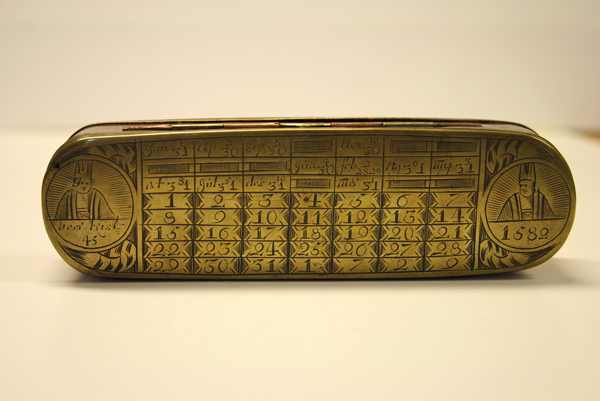1729
The Dutchman’s Log Box
Perpetual calendar and speed chart engraved on tobacco box, dated 1729.
This eighteenth century copper and brass container for tobacco was designed especially for navigators. The lid is engraved with a perpetual almanac that allows the owner to determine the day of the week and on the base is a table used to calculate the ships speed.
Description of the object
In the acquisition register of the National Museum of Ireland’s Metalwork Collection, the original entry for this object, numbered DM:1971.365, reads:
“Tobacco box, brass, Dutch, probably late seventeenth century. Long, deep, rectangular box, with short ends rounded. Hinged lid with reeded rim. Reeded rim also around base. Engraved on lid with calendar and, on either side, head and body of a priest or bishop.
Engraved on base with mathematical tables, figure of man with date 1497 and inscribed: 'Die deese doos /draagt in den sak, /Hoeft nooyt geen ander /almanak’ [meaning: He who carries this box in his pocket, will never need another almanac]. Inscribed on side of box: 'Regt Door Zee' [meaning: Straight ahead]”.
The outside dimensions of the object are: 16,2 cm; 4,5 cm; 3,3 cm.
The two portraits decorating both sides of the box’s lid are of Julius Caesar and Gregory XIII, with the dates 45 BC and 1582 AD engraved underneath, which indicate the introduction of the Julian and Gregorian Calendars. On the top end of the underside is the bust of a man with a globe with the date 1497 AD underneath, this represents Amerigo Vespucci.
This Dutchman’s log box is part of the bequest collection of Harry Percival Swan (1879-1970), a writer, historian and collector of antiquities from Co. Donegal. Swan left a collection in his will to the Royal Irish Academy that was subsequently donated to the National Museum of Ireland in 1971.
Who made this object?
The Dutch navigators’ tobacco boxes are associated with Pieter Holm (1685/86-1776), a Swedish second mate, who in the late 1720s settled in Amsterdam. After retirement from the navy, Holm established a sailing and navigating school called ‘Regt door Zee’ and a shop with maritime equipment and instruments. His own nautical experience and knowledge allowed him to simplify the calculation of a ship's speed at sea. Holm designed a chart “Zee-Meeter” [meaning: Sea Measurer] which shows the estimated speed instantly. For the convenience of navigators, he engraved his table on the lids of tobacco boxes that easily fit into the pocket.

Fig. 2: Reverse of Dutch decorated Tobacco box
How do you use this nautical instrument?
Although this tobacco box could still have been used as a practical storage container, it mainly served the more serious purposes of calculating the speed of the ship and determining the day of the week. To find out the speed, two steps should be followed. First, measure the time interval needed for a floating object thrown outboard to pass between two exact points marked on deck. Second, find the time value on the left column and read the estimated speed from the related speed cell. The perpetual calendar table is cleverly designed to indicate the days in the month that fall on the same weekdays.
Learn More
This object is part of the Museum’s Reserve Collection. However, thanks to curator Jennifer Goff, it will be put on public display at the visible storage exhibition, What's In Store?.
Visit the exhibition to see the tobacco box and find out more about the Museum's scientific instruments.
It is located on the ground floor of the North Block at the National Museum of Ireland – Decorative Arts and History.
Read More
Bennett, J.A. (1987). The divided circle: a history of instruments for astronomy, navigation and surveying (Vol. 1), 31.
Crone, E. (1953). Pieter Holm and His Tobacco Box (No. 24). Marine Historical Association.
Kisluk-Grosheide, D.O. (1988). Dutch Tobacco Boxes in the Metropolitan Museum of Art: A Catalogue. Metropolitan Museum Journal, 23, 201-231.
Location:
The Dutchman’s Log Box is located at:
In Storage
Previous artefact:
Next artefact:
